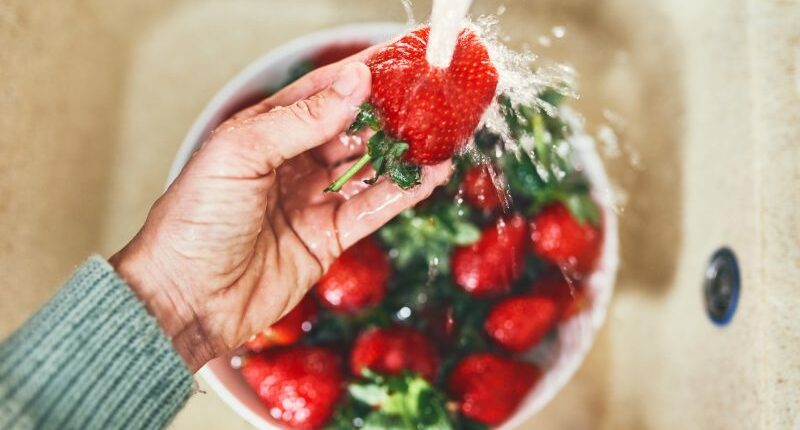Share this @internewscast.com

(NEXSTAR) – You might not get sick from popping an unwashed grape in your mouth. But would it be significantly less risky if you rinsed it off?
Without a doubt, according to experts.
Although it might not always appear to be the case, washing and gently scrubbing your produce under running water—just using water—can effectively remove some dust, debris, bugs, pesticides, and even harmful bacteria that have accumulated on the surface of fruits or vegetables. However, this method is not entirely effective in removing all pathogens or completely eliminating the risk of foodborne illness.
“No washing method completely removes or kills all microbes that may be present on produce, but studies have shown that thoroughly rinsing fresh produce under running water is an effective way to reduce the number of microorganisms,” according to a guide on washing produce by Colorado State University, in collaboration with the U.S. Department of Agriculture.
Numerous studies have reached similar conclusions regarding the effectiveness of washing produce with water. One study, conducted in 2006 by researchers at Tennessee State University, found that surface bacteria could be “significantly” reduced by pre-soaking and then rinsing certain fruits and vegetables—specifically apples, tomatoes, and lettuce. However, there is a substantial caveat: Some items, such as broccoli, and even the blossom ends of apples (opposite the stem), were found to have more bacteria after the soaking process, potentially transferring surface organisms into the crevices or less accessible parts of the produce.
“The uneven surfaces characterized by stem and blossom ends could result in the accumulation of more bacteria,” said the researchers, who recommended discarding these parts of the fruits or vegetables rather than eating them raw.
The Food and Drug Administration does not currently include a pre-soaking process among its guidelines for washing produce, likely for reasons involving potential cross-contamination. But if consumers insist, the guide published by Colorado State University suggests using a clean bowl rather than a sink, as the surfaces of a sink could potentially harbor bacteria.
Another study, published last year by researchers in Saudi Arabia, said soaking certain vegetables in a solution containing 5% vinegar (and then rinsing with water for several minutes) could help reduce E. coli levels when compared to just rinsing them under water. But both studies acknowledged that rinsing fruits and veggies in water alone was still effective in reducing pathogens.
The latter study also noted that products marketed as vegetable washes, in general, did not outperform water when it came to microbial reduction.
The Food and Drug Administration, too, says such washes are “not recommended” as they can contain ingredients that might soak into more porous produce.
“Also, the safety of the residues of commercial produce washes is not known and their effectiveness has not been tested,” the FDA writes.
Among the FDA and USDA’s other advice for washing produce, the agency advises washing hands with soap and water before handling fruits or vegetables (to prevent the introduction of new bacteria) and scrubbing more firm produce — such as potatoes or melons (which may have more creviced surfaces) — with a dedicated produce brush.
One exception to the rinsing rule, however, concerns bagged lettuces or produce items labeled as “pre-washed.” In those cases, no further rinsing or washing is necessary, the agencies say.
If consumers have further concerns, they can wipe down their vegetables with a clean towel (after washing) “to further reduce bacteria that may be present on the surface,” according to the FDA. But aside from thoroughly cooking produce, there’s no way to kill all of the potentially harmful bacteria.
“Washing can reduce bacteria that may be present but will not eliminate it,” the agency says.














